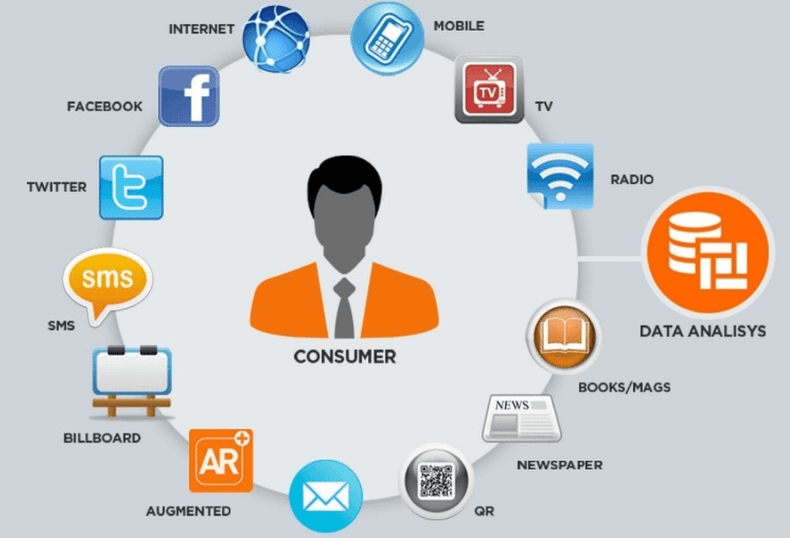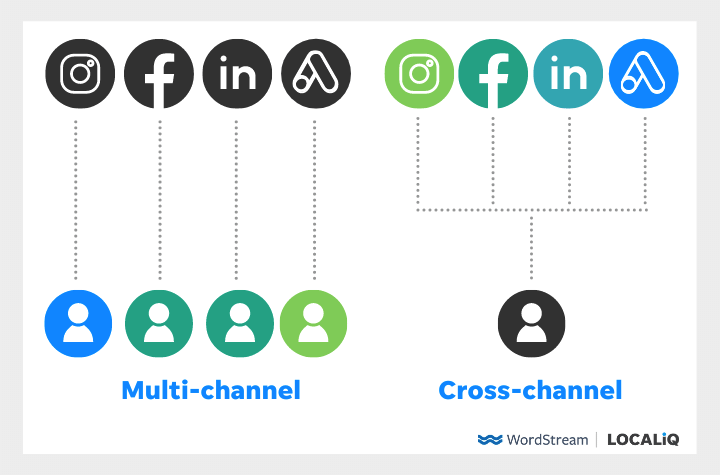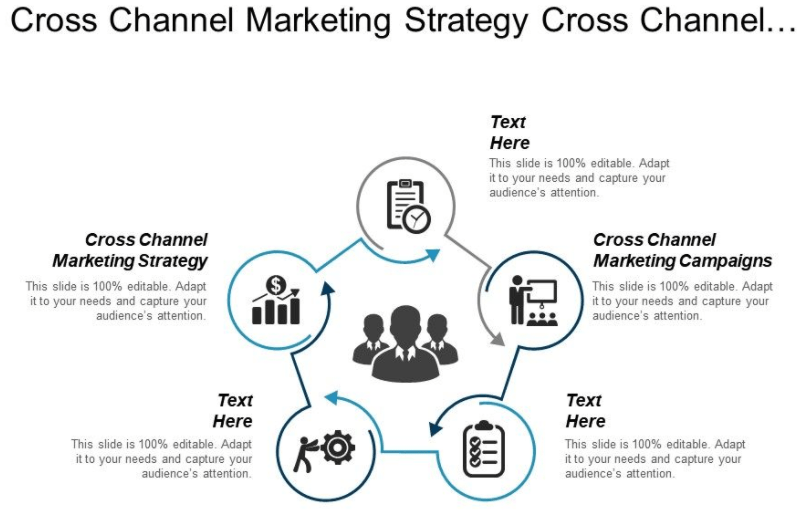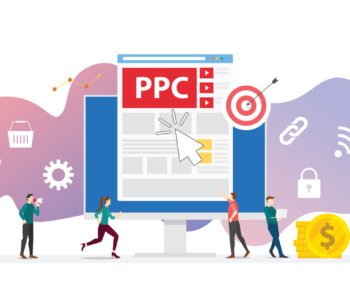Table of Contents
What Is Cross-Channel Marketing?
Cross-channel marketing is a strategic, customer-focused digital marketing technique used by marketers around the world to provide a consistent experience for their customers as they interact with their brands across multiple digital channels. This is a powerful way to shape your marketing strategy to create customer journeys that involve different channels.
Implementing a cross-channel marketing strategy can be a bit intimidating. You need to consider multiple channels when designing your campaigns. Tracking each campaign and consolidating their analysis is certainly not an easy task.
But before you learn how to build a successful cross-channel marketing strategy, let’s understand why this is necessary in the first place.
Why should you consider cross-channel marketing?
Cross-channel marketing enhances the buying experience of customers through personalization. It allows you to reach your customers across multiple channels to make sure your brand is always in front of their eyes.
Through cross-channel marketing, you can move your opportunities smoothly through the sales funnel across multiple channels. You can start your marketing on the second channel from where you left off on the first channel.
With the growing number of marketing channels, you need to have an effective cross-channel marketing strategy for your marketing campaigns. Make sure your brand is in front of your audience at all times. That way, they have a better chance of switching.
Tips for Creating a Winner Cross-Channel Marketing Strategy
Here are some tips to help you create a winning cross-channel marketing strategy:

1. Develop a buyer persona
An understanding of buyer persona is essential before designing your marketing strategy for your customers. For this, you need to create rich buyer people who are aware of your customers ’preferences, behavior, buying habits, and preferred methods of communication. If you already have a following on social media, you can use Social Listening to achieve that. Through this, you can find the needs, desires, and pain points of your audience. These are crucial in developing your buyer persona.
Take the time to create these people to find out what your customers like and dislike. Think beyond the classic customer behavior patterns to come up with a different range of buyer profiles. Remember, the better you know each of your buyers, the more accurate your strategy will be.
Check your buyers. What do they buy? What is their purchase frequency? How is this purchase done? Where is the traffic coming from?
One of the most effective ways to do this is to simulate buyer travel. Start by exploring their website, search by various categories, place an order, and file a customer support claim. Basically, see for yourself the overall customer experience from start to finish payment. This will help you figure out what you have to offer your customers.
2. Use media that complement each other
You need to make a choice when choosing channels for cross-channel marketing. Some channels work better than others. Try to include all the channels where your audience interacts most with your brand.
For example, you can ask your customers to check in through your app when they are in your store or include the URL in an email.
Simple means complement each other:
- Retail Store/Mobile
- TV/Mobile
- Radio/Mobile
- Computer/TV
- Computer/Mobile
- Computer/Radio
3. Integrate your data
Putting all your data on the Customer Data Platform (CDP) is the backbone of cross-channel marketing strategy. You need to have analytics data available to capture and analyze the touchpoints of your leads.
Typically, this involves using browsing cookies or tracking URLs to link online activities with a personal leadership profile. Track and analyze emails sent to them and with whom they communicate.
You need to know what blog posts they read, the social media campaigns they are engaged in and the conversations your customer support team has with them. All of this data should be in your CDP.
4. Align content with specific buyer travel

Each customer’s journey is different and they should treat each one differently. It involves creating content specifically for individuals based on customer habits. As a result, your content strategy needs to be designed so that it adjusts well with the travel of all buyers.
For example, when a customer leaves their cart, you can send them an email offering a discount. Similarly, for those who buy your products, you can send them a thank you email. That way, they will connect to your content on another channel and take the action you want from them.
Additionally, personalization improves your sales as customers are more likely to participate with content that provides personalized recommendations. Nearly 84% of customers say it is important to act individually to win their business.
5. Influence social media
Social media is one of the most important channels for implementing cross-channel marketing strategies. Many social media platforms like Facebook, Instagram and Pinterest allow you to take advantage of visuals to connect with your audience.
Additionally, they give you the opportunity to communicate directly with customers; Not possible on most other channels. It can also help you increase your brand awareness, engagement and conversions. Learn about Influencer marketing.
Using social media, you can redirect your traffic to other channels and define your buyer personality as mentioned above. It is therefore essential to have a strong presence on social media to create a powerful cross-channel marketing strategy.
6. Paid social media
Paid social media allows for more sophistication in your cross-channel marketing strategy. For example, Facebook Pixel is a popular option that you use to target customers who visit specific web pages with related content. You can redirect customers on many social media platforms, Google AdWords, and other advertising networks.
7. Test with control groups
A control group is basically a group of customers who do not receive your ads from your marketing campaigns. Consider using different control groups to assess the effectiveness of your marketing campaigns that are not targeted by any cross-channel marketing.
They can be used to measure the effectiveness of engagement campaigns to determine which marketing campaign works best and which should be further optimized. Learn about social Media analytics.
Control groups also tell marketers not to use any marketing campaigns aimed at a specific segment of customers and to allow those customers to follow their usual path.
Once you have tested and analyzed your marketing campaigns, you can always send the same campaign to the control group after the test is over. Instead of sending false marketing campaigns all at once, you can test the effectiveness of your campaigns in small batches.
8. Invest in customer support

76% of customers say it is easy to find brands that meet their expectations. To make sure you don’t lose customers, you need to make sure your customer support is always available. You should do your part to solve all the problems to improve the satisfaction of your customers, otherwise, they can transfer to another brand.
Salesforce through channel image is especially important for e-commerce marketers who are prone to customer resentment when they do not have good customer support. So you need to invest in your customer support and add options like live chat and chatbot to your store. This will help you in resolving customer questions quickly.
You should aim to provide exceptional service that makes the customer feel respectful and valuable. It also increases customer loyalty and produces positive word of mouth that increases your brand awareness. Make sure your customer service interactions are running smoothly across all channels.
9. Integrate your findings
Creating powerful cross-channel marketing campaigns is one thing, but analyzing their insights can dramatically change your marketing game. Integrate your findings from your marketing campaigns to create a seamless experience. Learn about omnichannel marketing.
Ask yourself questions like:
- Does my social media strategy support my web strategy?
- Does my campaign display the same message on different channels?
- Did I target the right audience on each channel?
- Is the X social media platform better than the Y platform?
- When all the channels are well combined, the customer experience will be better. Your customers
- will be convinced and they will know what to expect every time they engage with your brand.
Challenges of Cross-Channel Marketing

Cross-channel marketing can be challenging because it makes the basic, simple customer journey more subtle and complex. Initially running a cross-channel campaign requires measuring a long list of media channels – and the number of channels continues to grow. When it comes to adopting new platforms, most brands put themselves on the curve, which leads to some common challenges.
1. Reaching the audience at the right time
Depending on the number of marketing channels, it can be difficult for marketers to choose the right way to effectively reach their target audience at the right time. With so many options, it can be difficult to estimate the best place and time to reach customers, especially as many of these platforms face changes in both customer intent and advertising/marketing capabilities.
According to 40 percent of marketers, their biggest challenge is to use sophisticated strategies to reach their target population at the right time. Media planners must choose the right time to display ads on all platforms, as well as follow the best practices for each channel. In advertising, what works for TV spots does not work for Facebook posts and planners need to know which message is most effective for each channel.
2. Achieving high data quality for better information
Data quality remains a challenge for many companies in cross-channel marketing. Nearly 34 percent of data leaders say they want to make better use of data insights in their business decision-making processes. However, 42 percent of customer analytics professionals struggle with data quality, which they see as their main challenge.
The amount that data companies collect is ever-increasing and it is important to know what data is really relevant in order to improve efficiency and understand user behavior. The higher the quality of data, the more accurate insights, which means companies can make more data-based marketing decisions. Without high-quality data, marketers will struggle to get action-packed, person-level insights that can be used to make future decisions.
Additionally, as we move toward the future of cookies, marketers will need to reconsider how and why they collect specific data. Many companies today rely on the insights provided by cookies and other customer tracking tools, but soon, these sources of information will virtually disappear. This growing challenge can only serve to increase the need for high-quality data.
3. Choosing the right advertising channel
Choosing the right ad. Media channels can be a challenge for many companies as it can be difficult to determine where and when your target audience spends most of their time. Not all platforms can reach your target audience, so it is important to understand the user at the granular level.
When creating a cross-channel plan, campaigns should work together on channels that connect to your target audience, to increase the chances that your message will reach their target audience at the right time.
When choosing advertising channels, consider the value of each channel and its location on the customer journey. It is also important to remember the main goal of the campaign – is it to get leads? Create impressions? Improve engagement? However, you need to evaluate which channel can provide you with the results you are looking for.
4. Choosing the right marketing attribute
Most companies are still lagging behind in terms of marketing attribution and data quality. Consider the following:
Only 21% of marketers use the marketing attribution model and use it regularly in their campaigns. Learn about different types of social media.
Less than 1 in 2 corporate strategies cited data and analysis in their corporate strategies.
Marketers continue to track metrics such as click-through rates while lowering other metrics. If 1 percent of viewers click on an ad or link, 99 percent of viewers who see the ad will not be able to click, even if the ad then has an impact on conversions in the pipeline.
In the case of marketing analytics, both Media Mix Modeling (MMM) and Multi-Touch Attribution (MTA) have their limitations. It is not possible to combine them, provide real-time data, or provide a comprehensive overview of campaigns. Instead, marketers need to take a more comprehensive approach to attribution by combining raw data and personal-level insights.
Examples of brands that use cross-channel marketing
When done correctly, cross-channel marketing provides brands with a better understanding of their customers, which can serve as a guide for future campaign decisions. Here are two brands that have had success using multiple channels in their campaigns:

1. Mercedes Benz
Mercedes-Benz has used a promotional strategy with both digital and offline modes to launch its CLA product and the company claims it is the best product launch in 20 years. They used research from their “Generation Benz” online community to communicate their strategy and gain awareness about their customers.
To launch the CLA, he chose to do a Super Bowl announcement with Usher and Kate Upton (incidentally, the Super Bowl was held at a Mercedes-sponsored stadium). He created the microsite for his product, bought Facebook ads, and created the hashtag #clatakethewheel to drive the engagement.
He is also involved in Influencer Marketing by partnering with Casey Neistat, a leading Instagram photographer and leading YouTube person. By the end of the campaign, Mercedes had garnered more than 85 million organic impressions and nearly 2 million likes, and the CLA model alone contributed to the company’s November sales profit, up 14 percent from the previous year.
2. Starbucks
By using its app, Starbucks combines offline and online experiences. With the help of the Reinforcement Learning Platform, the app rewards customers with their purchases and also offers personalized recommendations based on their shopping habits. Customers will also receive push notifications for Starbucks sales or other promotions, which will encourage more traffic.
Through a unified experience, Starbucks effectively meets where its customers are almost every moment. Artificial intelligence provides consumer insights that not only understand behavior but also evaluate it. In real-time, customers can check in and reload their cards directly from their phones, making it as easy as possible for customers to shop from anywhere and anytime.
Final thoughts
By influencing data insights from your marketing campaigns, you can constantly improve to ensure that your cross-channel marketing strategy delivers real results.
A cross-channel marketing strategy is an effective and sophisticated way to reach your audience. A powerful cross-channel marketing strategy will help you do everything from raising brand awareness to creating leads and driving high sales.
You need to make sure that your content and customer service are well connected with each channel to provide a seamless transition to your audience. Test your strategy with control groups and improve it until it gets it right.
Are there other factors you need to consider when implementing a cross-channel marketing strategy or do you have any suggestions to add? Let me know in the comments.





